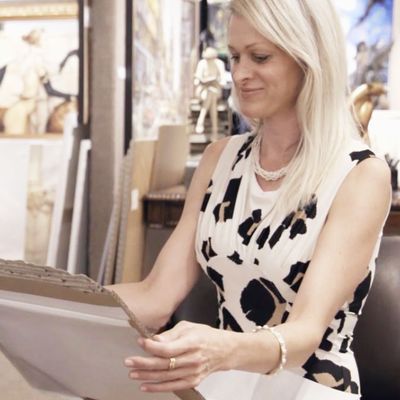
While the most damning appearances in the premiere episode of Sacha Baron Cohen’s Who Is America? go to gun-rights advocates Philip Van Cleave and Larry Pratt — pledging full support to a “Kinder-Guardians” gun program does that — by far the most delightful impression wasn’t made by a prominent figure at all. That distinction instead goes to Laguna Beach art gallerist Christy Cones, who, for her entire interview with Baron Cohen’s ex-con character Rick Sherman, exuded sympathy, wit, and eagerness to help the man reform himself with the help of art after two decades behind bars — even if that meant expounding on the “oxymoronic, paradoxical juxtapositions” of his fecal paintings or cutting off some of her own pubic hair for his custom paintbrush. To learn more about how she found herself in one of the year’s most divisive shows, Vulture gave Cones a call to discuss her truly once-in-a-lifetime experience.
Under what guise did the show approach you?
Well, let me start by saying they showed seven minutes of what was an hour-and-a-half interview with no cuts. I wish there was some way to see the rest of the footage because I thought it was a probing analysis of art. What is art? What is art’s function? It’s important to ask in our society, especially nowadays, given the widespread cultural denigration going on. The way I remembered it happening was that I was approached in mid-May last year, and initially somebody came into the gallery. They said they were from a British reality television show and that they were showing the works of artists and they were going to come in and show the work of an artist. I said, sure. We had a few email exchanges, phone calls, and within three or four days, they were here. There was a girl named Alexis who fronted the whole thing. She had me send her a short video about myself, which, in retrospect, was probably what they used to make the picture of me, where he acted like he made it in the bathroom.
Why do you think they scouted your gallery in particular?
I know we weren’t an anomaly. I know they approached at least one gallery in the area before us. I don’t think they were specifically focused on our gallery. But let me tell you this — out of all of the galleries in Laguna Beach, we’re the one that’s most amenable to giving a good show. We have a lot of space and we’ve been here a long time. We’re just a really fun gallery. When you walk in most galleries, it’s like 15 or 20 pieces are hanging on the wall in a 1,000-square-foot space, max. But we’ve got 3,000 square feet and lots of art, lots of room, lots of couches, and the best Cabs, the best Chardonnay, and the best Veuve Clicquot.
When the interview was taking place, were there any red flags that made you question whether “Rick Sherman” was presenting himself in good faith, or that he was trying to manipulate you to say or do certain things?
I certainly suspected that something might be amiss. How often does someone come to you and say, “Hey, we’re from a reality television show and we’re doing this and that.” People warned me beforehand to watch out, as it might be some kind of a setup. So I knew that. But none of that bothered me. As soon as the camera went on, my main concern was putting on a good show. I’m a thespian myself, so I wanted to appear entertaining and engaging. We were all in this trancelike state for 90 minutes where we let the art go.
So you never felt manipulated to cut off your pubic hair?
They cut it so you don’t get the full story there, but I wouldn’t say I was manipulated. And even if I were, I think a person can be manipulated and at the same time have free will. The two aren’t necessarily mutually exclusive. I hope that doesn’t sound profound or anything. I really believe it. I definitely wanted to be entertaining and I know that was an obeying moment. The important thing is, in my perspective, everything is fair game for art. Especially when you live in a time period like we live in.
Do you believe the paintings were actually made of feces and ejaculate?
I don’t believe that is was, but it stunk, whatever it was. When I went in the bathroom afterward, it smelled really bad. I was afraid to touch anything because I’m a bit of a hypochondriac. When he brought that painting out to show me, I was like, Ewwwww. Of course they didn’t show that part. As much as I was putting on a show — I was constantly gesticulating with my hands and overexaggerating all my movements and pulling out words I normally wouldn’t use in an everyday setting — but in the back of my head, something was saying, This guy could really be someone who went to prison and held people up and was a psychopath. He was like a walking time bomb who could blow up at any moment. A part of me honestly did think that. I didn’t want to take someone who was freshly out of prison, and would be in such a vulnerable, psychological state, and say anything to bring them down. At one point, I made a few critical remarks that they didn’t show in the final version and he gave me an untowardly look, and I was sort of frightened and taken aback a bit. It’s like, Okay, if this is real, I can really hurt his feelings and he’d flip out. There’s no telling what might happen.
I’m curious to get your take on Who Is America? as a whole. Do you consider it legitimate performance art?
Of course it is, absolutely. That moment of realization came to me when he showed me his work, created with his feces and bodily fluids. It’s a microcosm for the show. With what he provided me with, most people would say it’s crap. “It’s literal shit on a piece of paper, blah blah blah.” I think that’s what a lot of people’s immediate reactions would be to this show. It’s just a guy lying and he did it ten years ago and his career’s failing and he has a huge ego and is a narcissist. But the thing is, I sincerely believe, even in all that darkness, there is a light. We have to ask questions about ourselves and our own values. Sometimes the best way to do that is remembering to keep a smile and to laugh. You got to learn to laugh.
As far as I’m concerned, art has always been at the forefront of bringing to light modern issues that have importance to a culture and a society. And every once in a while, certain people have to be sacrificed on the altar of art for that to happen. That’s both the artist and the subject. Essentially, Sacha is carrying on a long tradition that was started thousands of years ago by guys like Aristophanes and Petronius and Jonathan Swift and Voltaire. Art and satire, it hurts. I just wish everybody would quit taking themselves so seriously.
Christy Cones is a fine-arts consultant at Coast Gallery in Laguna Beach, California. Per her request, please click here to learn more about Bruce Hopping, and how his Kalos Kagathos Foundation promotes art and the environment.


